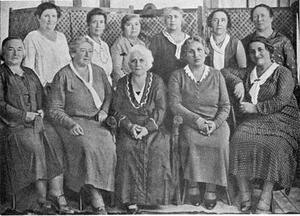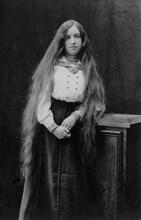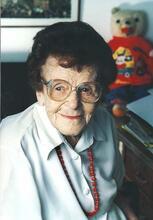Nehamah Pukhachewsky
Courtesy of Ha-Keren le-Ezrat ha-Isha.
Nehamah Pukhachewsky was born in 1869 in Lithuania. Her parents provided her with instruction in Hebrew and the Bible, helping grow her religious identity and educational diligence. In 1889, Nehamah and her husband Michael immigrated to Palestine under the sponsorship of Baron Edmond de Rothschild. Along with raising two children, Pukhachewsky wrote for Hebrew journals, farmed, advocated for women’s rights, and founded charitable organizations. Her short stories discussed agricultural life while covering feminist issues such as economic independence and Jewish divorce law. Her extensive body of work written in both English and Hebrew provides a window into daily life in Palestine during the First Aliyah from the perspective of a pioneering Jewish feminist author.
It is puzzling, the tendency of men to love and hate at the same time, to pursue a woman and seek intimacy with her and at the same time to trample on her dignity. For it is a contradiction in terms—to despise the one you love, the one with whom your life is bound up, with whom you establish your family and your position and build your future. A man denigrates his lifelong companion and at the same time demands that she give him honor, derides her and yet expects that all her soul and all her thoughts be devoted only to him.
(Bakefar u-va-Avodah, In the Village and at Work, 1930)
These lines, taken from a novella by Nehamah Pukhachewsky, one of the first modern Hebrew women prose writers, typify Pukhachewsky’s protofeminist Hebrew writing and provide a rationale for her lifelong activism on behalf of Jewish women.
Early Life and Immigration to Palestine
Nehamah Pukhachewsky (née Feinstein), born in Brisk (Brest-Litovsk), Lithuania, on March 27, 1869, was the only daughter of her hasidic parents, Yonah Zvi and Blume (Milkhiker) Feinstein. When she was nine her parents moved to Tsarizin (later Stalingrad), where Nehamah studied and excelled at the gymnasium. After four years her parents removed her from the gymnasium, fearing she would lose her religious identity. Instead, they provided her with private tutoring, including instruction in Hebrew and Bible. She was a diligent student and from an early age began corresponding in Hebrew with the leading Hebrew writer and poet of her day Judah Leib Gordon (1831–1892). In a letter dated January 3, 1886, Gordon wrote to Feinstein that he could hardly believe that she was only sixteen years old and had in two years managed to master enough Hebrew to compose such a long, well-written letter. “Happy are your parents, to whom God gave such an intellectual daughter, and happy is the man whom you allow to enjoy life with you” (Kitvei Y. L. Gordon, p. 211).
In 1889 she married Michael Pukhachewsky (1863–1947), one of six young men who had been selected by the Members of Hibbat ZionHovevei Zion movement, under the sponsorship of Baron Edmond de Rothschild, to study agriculture in Palestine. The same year, the couple moved to Palestine and settled in Rishon Le-Zion where they raised a son, Asahel, and a daughter, Efrat. (They also had two other sons who died before the birth of Asahel.) In addition to raising her children, Pukhachewsky was a farmer and writer. She also participated actively in communal life and in the fledgling women’s rights movement. She served on the Council of Rishon le-Zion, its judicial and cultural committees, and as chairwoman of the women’s union. She helped found Linat Zedek (a hostel for the poor) and Kuppat Malveh (the cooperative loan bank) and was an active member of WIZO. She also maintained a strong connection with the Yemenite community in Rishon, helping to mediate disputes and working on behalf of educational opportunities for Yemenite girls.
Authorship & Advocacy
From an early age, Pukhachewsky began writing articles and stories for Hebrew journals, often under the pen name “Nefesh.” Among the most significant pieces at this early stage was an article published in Ha-Meliz (“More on the Question of Daughters,” 1889), which advocated Jewish education for girls. Other important articles included a rejoinder, published in Ha-Shiloah (1908), to a controversial article by Izhac Epstein (1862–1943) about the acquisition of Arab lands in Palestine, “The Obscure Question.”
Pukhachewsky’s first collection of short stories, Bi-Yehudah ha-Hadashah (In the New Judea), was published in 1911. The first five stories depict Jewish farming life in Palestine; the last five portray the Yemenite community in Rishon. Several of the stories address issues of feminist importance, including the notion of female economic independence in “Ha-Avedot” (The Losses), the inequities of Jewish divorce law in “Pa’amayim” (Twice), and the status of the barren woman in Jewish life in “Galut” (Exile), a subject which was also addressed in a later story, “Asonah shel Aphiah” (Aphiah’s Plight, 1925). According to critic Nurit Govrin all of these stories are based in some way on actual events from Pukhachewsky’s community, which she recast in more tragic, pessimistic form. Scant critical attention was accorded this volume by contemporary critics, with the exception of two reviewers who objected strenuously to the recurrent catastrophes and calamities depicted therein. “Where the reader hopes to encounter much life,” writes Jacob Zerubavel (1886–1967), “he trips at every step over dead bodies” (Jacob Zerubavel in Ha-Ahdut, November 6, 1912). More recent critics, such as Govrin and Yaffah Berlovitz, have also puzzled over the question of why such a productive, successful woman chose to write stories about relentless tragedy and failure, highlighting the ways in which the stories use tragedy to protest the status of Jewish women.
Perhaps in response to the negative reception of Bi-Yehudah Ha-Hadashah, Pukhachewsky’s second volume, Bakfar u-va-Avodah: Sippurim (In the Village and at Work, 1930), includes one or two stories that end slightly more happily; by and large, however, gloom and misfortune predominate. As in Bi-Yehudah Ha-Hadashah, there is a great deal of feminist protest in this volume, including several passages polemicizing against the devaluation of women’s work in the A voluntary collective community, mainly agricultural, in which there is no private wealth and which is responsible for all the needs of its members and their families.kevuzah (commune). The most successful novella in the volume is “Bi-Vedidut” (In Loneliness), written in the form of diary entries, which tells the story of a forty-year-old woman who lives and works on a farm with her unremittingly misogynistic brother. In the last years of her life, Pukhachewsky wrote an unpublished novel called Ba-Midron (On the Slope), the story of a chronically unsuccessful Jewish farmer named Haim Selzberg, which was only published in 2004.
Nehamah Pukhachewsky died on May 21, 1934.
Selected Works
Hebrew
In the New Judea: A Collection of Stories. Jaffa: 1911
In the Village and at Work. Tel Aviv: 1930
“More on the Question of Daughters.” Ha-Meliz, 7 Adar (March 10) 1889, 2–3
“Revealed Questions.” Ha-Shilo’ah 18, 67–69
“Aphiah’s Plight.” Ha-Shilo’ah 43 (Tishrei–Adar 1925–1926): 227-233, reprinted in Ha-Kol ha-Aher: Sipporet Nashim Ivriyyot, edited by Lily Rattok. Tel Aviv: 1993, translated as “Aphia’s Plight” in Ribcage: Israeli Women’s Fiction, edited by Carol Diament and Lily Rattok. New York: 1994.
Hebrew
Ehud Ben Ezer. “Review of Nehamah Pukhachewsky’s In The New Judea.” Ha-Aretz, November 24, 1972.
Berlovitz, Yaffah. “The Dominant Text and the Hidden Text: A Consideration of the Work of Nehamah Pukhachewsky. Alei Siah 27–28 (1990) 105–113; Albany: 1993.
Berlovitz, Yaffah, ed. Tender Rib: Stories by Women Writers in Pre-State Israel. Tel Aviv: 2003, 81–92.
Govrin, Nurit. “Nefesh from Rishon le-Zion Clamors: Nehamah Pukhachewsky.” In Honey From the Rock: Studies in the Literature of Erez Israel. Tel Aviv: 1989, 114–171.
Lubin, Orly. A Woman Reads a Woman. Haifa: 2003, 101–116.
Smilansky, Moshe. “Nefesh.” In Family of the Land. Tel Aviv, 1943, 242–244.
Shaked, Gershon. “The Genre and its Parts: Considerations of the Fiction of Moshe Smilansky and Nehamah Pukhachewsky. In On Poetry and Fiction: Studies in Hebrew Literature, edited by Tsvi Malakhi, 133–146. Tel Aviv: 1977.
English
Bernstein, Deborah. “Literature by Women of the First Aliyah.” In Pioneers and Homemakers: Jewish Women in Pre-State Israel, edited by Deborah S. Bernstein. Albany: 1993.
Zierler, Wendy. And Rachel Stole the Idols: The Emergence of Modern Hebrew Women’s Writing. Detroit: 2004, chapter 4.






